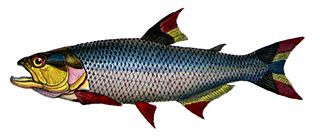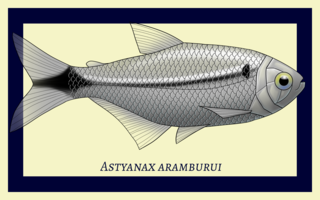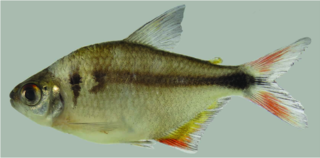
Characidae, the characids or characins is a family of freshwater subtropical and tropical fish, belonging to the order Characiformes. The name "characins" is the historical one, but scientists today tend to prefer "characids" to reflect their status as a by and large monophyletic group at family rank. To arrive there, this family has undergone much systematic and taxonomic change. Among those fishes that remain in the Characidae for the time being are the tetras, comprising the very similar genera Hemigrammus and Hyphessobrycon, as well as a few related forms such as the cave and neon tetras. Fish of this family are important as food and also include popular aquarium fish species.

Hyphessobrycon is a genus of freshwater fish in the family Characidae. These species are among the fishes known as tetras. The genus is distributed in the Neotropical realm from southern Mexico to Río de la Plata in Argentina. Many of these species are native to South America; about six species are from Central America and a single species, H. compressus is from southern Mexico.

Astyanax is a genus of freshwater fish in the family Characidae of the order Characiformes. Some of these fish, like many of their relatives, are kept as aquarium pets and known collectively as tetras. With around 150 described species and new ones being described yearly, this genus is among the largest of the entire order; Hyphessobrycon also has more than 145 species and which one is larger at any one time depends on whether more species have been recently described in one or the other. The blind and colorless cave tetra of Mexico is a famous member of the genus, but its taxonomic position is disputed: Some recognize it as part of the Mexican tetra and this is supported by phylogenetic evidence, but others recognize the cave form as a separate species, A. jordani.

Bryconops is a genus of freshwater fish in the family Iguanodectidae from South America. It consists of small fish, all under half-a-foot long, with slender bodies and silvery scales, though there is some mild color variation. Several species can be identified by way of a humeral patch, and others have a reddish ocellus, or eyespot, on one or both lobes of the dorsal fin.

Moenkhausia is a genus of freshwater fish in the family Characidae native to tropical and subtropical South America. These are medium-sized tetras where the largest species only reach around 12 cm (4.7 in).

Salminus, popularly known as dorado or dourado, is a genus of relatively large, predatory freshwater fish from the family Characidae. They are native to large tropical and subtropical rivers in South America, and undertake migrations during the rainy season to spawn. They are very popular among recreational anglers and also support important commercial fisheries.

Bryconamericus is a genus of characins found in Central and South America.

Gephyrocharax is a genus of characins found in South America, Trinidad in the Caribbean, and Panama.

Hasemania is a genus of characins endemic to Brazil, where only found in river basins that originate on the Brazilian Shield, ranging west to the Juruena system, north to the São Francisco system and south to the Paraná system. The individual species generally have quite small ranges and two, H. crenuchoides and H. piatan, are considered threatened by Brazil's Ministry of the Environment.

Hemigrammus is a genus of freshwater fish in the family Characidae native to South America and commonly seen in the aquarium trade. These are medium-small tetras where the largest species reach up to around 11 cm (4.3 in).

Carlastyanax aurocaudatus is a small species of freshwater fish in the family Characidae native to the Río Cauca in Colombia. It is the only member of the monotypic genus Carlastyanax, which was named in 1972 specifically for the species by Jacques Géry. Upon description, it was named Astyanax aurocaudatus by Carl H. Eigenmann. There has been debate concerning whether or not the genus should be recognized, but C. aurocaudatus is currently considered a valid species.
Phycocharax rasbora is a small species of freshwater fish in the family Characidae and the only member in the genus Phycocharax. It is endemic to the Brazilian Amazon, where only known from the upper Braço Norte River, a blackwater tributary in the Teles Pires basin, itself a part of the Tapajós basin. A dam has been built on the Braço Norte River and while the species is uncommon downstream, it is very abundant in the reservoir above. Its species name refers to the similarity in color and pattern to Trigonostigma rasboras, an unrelated but well-known Asian fish. The mainly reddish males reach up to about 3.4 cm (1.3 in) in standard length, while the duller yellowish females reach up to about 3.1 cm (1.2 in).
Pristella crinogi is a freshwater fish in the family Characidae of the order Characiformes. It is a tropical fish. It resides in the basins of the Tocantins River and São Francisco River.
Pristella ariporo is a freshwater fish in the family Characidae of the order Characiformes. It is a tropical fish. It resides in the basin of the Orinoco in Colombia.

Astyanax abramis is a small freshwater fish from the inland rivers of South America. It is plentiful in almost the entire continent, with a habitat including the La Plata, upper Amazon, and Meta River basins. The body shape is subrhomboidal and laterally compressed, and the scales are largely silver, with a blue or green tint on the dorsal side.

Astyanax aramburui is a small freshwater fish from the rivers of South America, restricted to a relatively small region within the Paraná and Uruguay river basins of Argentina. It was named after the scientist who established a professional presence for ichthyology in the country, Raúl Arámburu. Considered a near-threatened species by the IUCN, its range includes creeks in a sub-basin affected by various forms of pollution.

Astyanax asuncionensis is a small species of freshwater fish described in 1972 from Asunción, the capital of Paraguay in South America. Its specific epithet is in reference to this. Currently, its range is known to encompass areas of not just Paraguay but also Argentina and Brazil. It is an adaptable, omnivorous species that easily lives in sympatry with various congeners.

Astyanax bagual is a small species of freshwater fish known only from the Taquari-Antas river basin in southern Brazil. It is unusual in the genus Astyanax because mature male specimens display bony hooks on the rays of all fins; in opposition, most others have them on the anal, pelvic, or pectoral fins - sometimes on more than one of these, but very rarely on all fins. It can further be told apart from various congeners by way of dentition and some aspects of coloration, including the presence of two humeral spots instead of one.
The Mato Grosso astyanax(Astyanax apiaka) is a small freshwater fish endemic to the Apiacá river in Mato Grosso, Brazil. Its discovery is recent, as of 2023, which results in little published research of its natural behaviors or preferred biotopes. However, descriptions of its appearance and general environment have been solidified, as well as some baseline information regarding its diet. It lacks a conservation status from the IUCN.

Deuterodon heterostomus is a small species of characin endemic to a large river system in southeast Brazil. It was originally the only member of the genus Probolodus, but Probolodus is now considered obsolete, synonymized with Deuterodon. Much like other members of Deuterodon, and like some fish in related genera, D. heterostomus is a small, silvery fish with fins in some combination of red and clear. It has a defined humeral spot that can be used for identification.
















